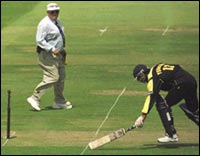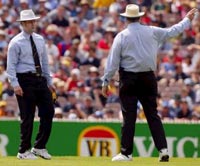Video killed the umpiring star
Daniel Laidlaw
The technological march has been advanced with the news from the ICC's
Cricket Committee-Playing meeting that the third umpire will be afforded
increased powers on an experimental basis for September's Champions Trophy
one-day tournament in Sri Lanka. This step is, if anything, long overdue.
 Let's face it, watching cricket on television we have long suspected that we
are better equipped to adjudicate on decisions than the umpires on the
ground. If that weren't true, commentators would not feel it necessary to
affirm or dispute every decision after viewing replays. Despite concerns
over the possibly misleading nature of TV pictures, it is clear that with
the aid of TV, a greater percentage of correct decisions can be made in
relatively quick time.
Let's face it, watching cricket on television we have long suspected that we
are better equipped to adjudicate on decisions than the umpires on the
ground. If that weren't true, commentators would not feel it necessary to
affirm or dispute every decision after viewing replays. Despite concerns
over the possibly misleading nature of TV pictures, it is clear that with
the aid of TV, a greater percentage of correct decisions can be made in
relatively quick time.
One-day cricket is a vehicle for experimentation so credit to the ICC for at
least trialling the expanded use of technology. The only concern is how it's
going to be implemented.
The ICC media release says that field umpires can consult the third umpire
on any aspect of a decision. Unlike for viewers, who can watch replays at
their leisure, the third umpire is only allowed two replays to help the
field umpire reach a decision, which is where the system becomes
problematic.
First of all, it is difficult to imagine an umpire responding to an lbw
appeal by keeping the batsman and bowler in suspense while pausing to
consult his upstairs colleague on whether the ball pitched in line or took
an inside edge. It would be like waiting on an inordinately slower version
of Steve Bucknor!
 Two replays should be sufficient for the third umpire to determine obvious
decisions, like a ball pitching outside leg stump, but not for uncertain
calls like whether or not the ball took a faint edge. Even though such
decisions are still to be made by the field umpire and not the TV umpire, it
will be impossible for the field umpire not to accept whatever the TV umpire
tells him without risking being made to look like a fool. The TV umpire
becomes the de facto decision maker on the basis of two replays.
Two replays should be sufficient for the third umpire to determine obvious
decisions, like a ball pitching outside leg stump, but not for uncertain
calls like whether or not the ball took a faint edge. Even though such
decisions are still to be made by the field umpire and not the TV umpire, it
will be impossible for the field umpire not to accept whatever the TV umpire
tells him without risking being made to look like a fool. The TV umpire
becomes the de facto decision maker on the basis of two replays.
And what kind of replay technology is the third umpire allowed to use? When
an umpire asks whether the ball pitched in line with the stumps, will the TV
umpire view the superimposed stripes that are part of cricket coverage now?
Can he utilise a version of the Snickometer to determine whether the ball
hit the edge of the bat?
While interesting, the scientific value of devices like the Snickometer must
be in question. Though not part of decision-making, there are serious doubts
over the accuracy of the speed guns used to time deliveries, despite the
claims. Australian wicket-keeper Adam Gilchrist felt Brett Lee's supposedly
record-breaking deliveries in the recent Test series were not particularly
quick. Will these gadgets be trusted as umpiring aids?
It was nice to see CC-P (Cricket Committee - Playing) Chairman Sunil Gavaskar acknowledge that umpires receive too little credit for the high percentage of correct decisions they make, as they surely have a more difficult job than officials in any other sport given the minute factors they must consider. But while the ICC wants to support umpires with technology, and this system should lead to better decisions and thus less criticism, what it actually tends to do is undermine their judgement. With consultation available, one suspects players will be less inclined to trust an umpire when he makes an unassisted decision.
It seems ironic that the ICC has finally established an elite panel of the
very best umpires only to tell them they should doubt the judgement for
which they have been selected by consulting with a TV umpire to determine
any aspect of a decision they are unsure of. Won't that erode some of skills
for which they were selected? Sure, consultation is optional, but so too is
calling for the third umpire to rule on a run-out. How often do umpires rely
on their own judgement now in anything resembling a close call?
By comparison with run outs, every lbw decision is close, with minute
factors to consider like whether the ball pitched in line, was travelling
over or past the stumps, and whether the batsman hit it. Knowing that
replays can quickly prove them wrong, even the best umpires surely won't
have the confidence to make a lot of decisions by themselves.
With umpires used to responding to appeals instantaneously, one imagines it
will also take some training for them to become accustomed to pausing and
asking for help. Despite the wording of the media release, maybe they will
still be encouraged to reach their own decisions in all but the most dubious
cases. The Champions Trophy should be interesting.
The ideal method of ensuring mistakes are avoided, or at least rectified,
remains giving the third umpire the authority to instantly over-rule any
decision on the field. This would obviously have to be done before the next
ball is bowled, and ideally would be used to correct only the most glaring
errors, like a batsman being wrongly given out LBW edging onto the pads or
not out when clearly caught behind. This would, however, undoubtedly
undermine the role of the field umpire. But the question is what is more
important to cricket: supporting the role of the umpire, or reaching a
greater percentage of correct decisions?
More Columns
Mail Daniel Laidlaw